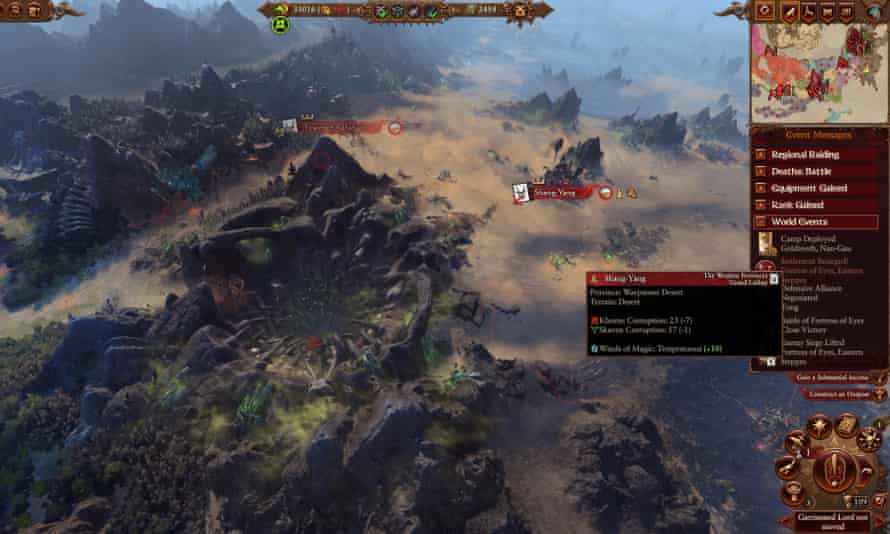Shared from Culture | The Guardian
When Game of Thrones ended, I promised myself I would never again become invested in a sprawling medieval fantasy where humanity makes a desperate last stand against an apocalyptic foe, at the onset of an endless winter. It felt like a safe bet at the time. Then that trailer dropped.
The finale of this grand strategy trilogy, set in the long-running Warhammer fantasy role-playing universe, never quite reaches the cinematic highs of the announcement video, but it comes impressively close; all swords, sorcery and symphonic metal. Too much story would only detract from the strategy sandboxes that define the Total War series anyway, where a Helm’s Deep or Battle of the Bastards can emerge spontaneously from any corner of its improv theatre of war. Still, if Warhammer 3 never hits such epochal fantasy plot beats, it provides one beautiful, batshit box of Lego for building your own.
The setup is the typical stuff of operatic fantasy: the roar of a dying god has torn apart the barrier that separates the mortal world from the daemonic realm of chaos. You play as one of eight factions with designs on that god’s power. Some want to protect their homelands. Some want dark glory. Some just want a good meal. Vivid lore snippets and vastly asymmetrical factions contribute to a heady blend of romantic and classical strategy game design. While it certainly helps if you’re already invested in the fate of the Old World on the eve of an onslaught by the ruinous powers, the freedom granted by Warhammer’s glorious silliness ultimately serves the genre by allowing for fantasy to inform tactical diversity. Battles veer towards the cinematic rather than the cerebral, but there’s still plenty of intense and interesting RTS gameplay.
Any IP this fleshed out and chronicled still brings its own restrictions, of course. How do you do the chaos god’s reality-bending potential justice while not devolving into an all-out power fantasy? How do you lay out an even playing field for dark deities and squishy mortals? Mate. This is Warhammer. You make each faction so uniquely overpowered that your plague-borne regenerative abilities cancel out my invocation of an ancient bear deity’s icy wrath. The result is a spectacular lateral expansion of the traditional Total War dynamic. The power curve eventually balances out, even if it violently contorts into a few flaming sigils on its way there.

There are a few outliers, of course. The game recommends either Slavic, icy Kislev or the undivided Daemons of Chaos as a first pick. Both are narratively satisfying extensions of an excellent story prologue, but Khorne’s destructive momentum and Cathay’s defensive bulwark are far more forgiving starters. A relentless spilling of demonic forces across the map makes for an intense, breathless campaign. Thematically evocative, sure, but also a contributor to the game’s biggest issue: a harsher autoresolve and tighter map means a tiresome number of forced manual battles.
Asymmetry aside, all factions share a campaign objective: navigate the four realms of chaos and wrest a Daemon Prince’s soul from each, while building your forces and securing your empire in the interim. It’s a structure that lets you play tall, or roleplay on the defensive, though painting the map and eliminating rivals is an alternate victory condition.
The eventual promise of the trilogy is “Immortal Empires” – a combination of all three games’ maps and factions into one grand depiction of the Old World. As such, most additions are quality of life changes rather than dramatic overhauls. The long-requested siege rework is still welcome, with mixed results. Towers and barricades are powerful, if a touch arcadey, but the real upgrade here is improved settlement map design. Open streets, palisades, perches and choke points make for a far more evolved and interesting take on a prevalent series weakness.
It’s also a real looker, providing you can find the beauty in blighted, fetid hellscapes and snow-capped crags. The setting’s real trick has always been how it stays tongue-in-cheek about its own excess while still worldbuilding with earnest imagination, and Creative Assembly cap off the trilogy with some of its most gripping – and funniest – writing. The continual design evolution of one project split over three full games and dozens of expansions makes me hesitant to call Warhammer III a landmark strategy game in its own right. But looking back now at that very first trailer, it does feel like a promise kept.
Images and Article from Culture | The Guardian

